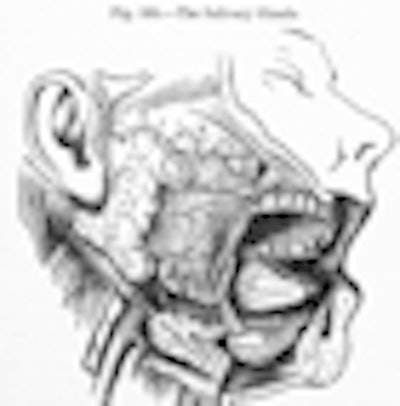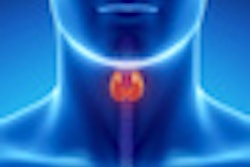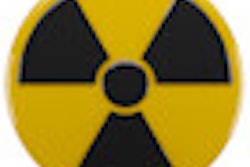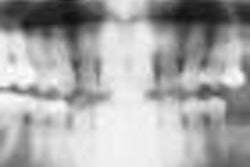
A new study in the European Journal of Radiology further supports the use of thyroid collars to reduce radiation dose exposure for patients undergoing cone-beam CT (CBCT) imaging of the oral and maxillofacial region.
The dose reduction is even more significant when middle or small field of view (FOV) is utilized, according to the study authors from Peking University School and Hospital of Stomatology (EJR March 2012, Vol. 81:3, pp. e376-e380).
Working with a DCT Pro (Vatech) and a 0.355 mm thyroid collar, the researchers took three scans -- one without the collar, one with a single collar around the front of the neck, and one with two collars (front and back) -- at three different FOVs. The scanning time was 15 seconds with a tube voltage of 90 kV.
The researchers used thermoluminescent dosimeter chips to measure the absorbed doses. Three chips were positioned at each of 21 locations -- including the thyroid, esophagus, mandibles, salivary glands, and eyes -- in the head and neck region of an anthropomorphic adult male phantom. Effective organ dose and total effective dose were derived using International Commission on Radiological Protection 2007 recommendations.
Significant reduction
When no thyroid collar was used, the total effective doses for large, middle, and small FOV were 2.54.3 micro-Sievert units (µSv), 249.0 µSv, and 180.3 µSv, respectively, according to the study authors. However, when a single thyroid collar was placed tightly around the front of the neck, the total effective doses were reduced to 208.5 µSv (18% reduction), 149.1 µSv (40.1% reduction, and 110.5 µSv (38.7% reduction), respectively. Using two collars did not significantly further reduce the total effective doses.
"By the use of a thyroid collar, the effective organ doses for thyroid gland and esophagus can be significantly reduced to a low level (p < 0.05)," the study authors wrote. "Therefore, thyroid shielding is strongly recommended during CBCT scanning for the oral and maxillofacial regions."
Since there was no significant difference on radiation dose reduction when two collars were used, the researchers recommend using only a single collar on the front of the neck.
In addition, although the radiation dose was significantly reduced by the thyroid collars, the total effective dose for middle FOV (149.1 µSv) was still higher than for small FOV (110.5 µSv), they added. Thus, according to the ALARA (as low as reasonably achievable) principle, the small FOV should be selected if the region of interest can be adequately imaged.
Growing body of evidence
Previous studies have yielded similar findings. At the December 2011 meeting of the American Academy of Oral and Maxillofacial Radiology (AAOMR), researchers from New York University (NYU), Stony Brook University, Columbia University, and Memorial Sloan-Kettering Cancer Center found that employing both leaded glasses and a thyroid shield during cone-beam CT scanning (Platinum i-CAT, Imaging Sciences International) reduced the radiation dose to the thyroid from 63.2 µSv to 36.0 µSv.
In addition, they found that the absorbed dose to the eye was 0.450 centi-Gray units (cGy) without leaded glasses or thyroid shield and 0.116 cGy with glasses or thyroid shield.
The research being conducted at Peking University School and Hospital of Stomatology further validates the American group's findings, according to Arthur Goren, DMD, clinical associate professor at NYU and Stony Brook, and co-author of the AAOMR research and related studies.
"No two cone-beam CT machines set at the same parameters emit the same radiation," he told DrBicuspid.com. "Their data is good only for their machine; our data is good only for our machine."
Even so, "their work and their findings parallel ours and shows that, with a different machine, you can get the same results" in terms of dose reduction using a thyroid shield, Dr. Goren said.
He recommends that thyroid shields and leaded glasses both be used during cone-beam CT scanning.
"The dose to the lens of the eye is cumulative over a lifetime, and if it reaches a certain level, it can lead to cataracts," he said.



















